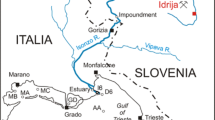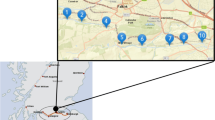Abstract
Mercury tracers are powerful tools that can be used to study mercury transformations in environmental systems, particularly mercury methylation, demethylation and reduction in sediments and water. However, mercury transformation studies using tracers can be subject to error, especially when used to assess methylation potential. The organic mercury extracted can be as low as 0.01% of the endogenous labeled mercury, and artefacts and contamination present during methylmercury (MeHg) extraction processes can cause interference. Solvent extraction methods based on the use of either KBr/H2SO4 or HCl were evaluated in freshwater sediments using 197Hg radiotracer. Values obtained for the 197Hg tracer in the organic phase were up to 25-fold higher when HCl was used, which is due to the coextraction of 197Hg2+ into the organic phase during MeHg extraction. Evaluations of the production of MeHg gave similar results with both MeHg extraction procedures, but due to the higher Hg2+ contamination of the controls, the uncertainty in the determination was higher when HCl was used. The Hg2+ contamination of controls in the HCl extraction method showed a nonlinear correlation with the humic acid content of sediment pore water. Therefore, use of the KBr/H2SO4 method is recommended, since it is free from these interferences. 197Hg radiotracer (T 1/2 = 2.673 d) has a production rate that is about 50 times higher than that of 203Hg (T 1/2 = 46.595 d), the most frequently used mercury radiotracer. Hence it is possible to obtain a similar level of performance to 203Hg when it is used it in short-term experiments and produced by the irradiation of 196Hg with thermal neutrons, using mercury targets with the natural isotopic composition. However, if the 0.15% natural abundance of the 196Hg isotope is increased, the specific activity of the 197Hg tracer can be significantly improved. In the present work, 197Hg tracer was produced from mercury 51.58% enriched in the 196Hg isotope, and a 340-fold increase in specific activity with respect to natural mercury targets was obtained. When this high specific activity tracer is employed, mercury methylation and reduction experiments with minimum mercury additions are feasible. Tracer recovery in methylation experiments (associated with Me197Hg production from 197Hg2+ spike, but also with Hg2+ contamination and Me197Hg artefacts) with marine sediments was about 0.005% g−1 WS (WS: wet sediment) after 20 h incubation with mercury additions of 0.05 ng g−1 WS, which is far below natural mercury levels. In this case, the amount of Hg2+ reduced to Hg0 (expressed as the percent 197Hg0 recovered with respect to the 197Hg2+ added) varied from 0.13 to 1.6% g−1 WS. Me197Hg production from 197Hg2+ spike after 20 h of incubation of freshwater sediment ranged from 0.02 to 0.13% g−1 WS with mercury additions of 2.5 ng g−1 WS, which is also far below natural levels. 197Hg0 recoveries were low, 0.0058 ± 0.0013% g−1 WS, but showed good reproducibility in five replicates. Me197Hg production from 197Hg2+ spiked in freshwater samples ranged from 0.1 to 0.3% over a period of three days with mercury additions of 10 ng L−1. A detection limit of 0.05% for Me197Hg production from 197Hg2+ spike was obtained in seawater in a 25 h incubation experiment with mercury additions of 12 ng L−1.



Similar content being viewed by others
References
Gilmour CC, Henry EA, Mitchell R (1992) Environ Sci Technol 26:2281–2287
Mauro JBN, Guimaraes JRD, Hintelmann H, Watras CJ, Haack EA, Coelho-Souza SA (2002) Anal Bioanal Chem 374:983–989
Marvin-DiPasquale MC, Agee J, Bouse RM, Jaffe BE (2003) Environ Geol 43:260–267
Gardfeldt K, Munthe J, Stromberg D, Lindqvist O (2003) Sci Total Environ 304:127–136
Siciliano SD, O’Driscoll NJ, Tordon R, Hill J, Beauchamp S, Lean DRS (2005) Environ Sci Technol 39:1071–1077
Furutani A, Rudd JW (1980) Appl Environ Microbiol 40(4):770–776
Guimaraes JRD, Malm O, Pfeiffer C (1995) Sci Total Environ 175:151–162
Stordal MC, Gill GA (1995) Water Air Soil Pollut 80:725–734
Summers AO, Silvers S (1978) Ann Rev Microbiol 332:637–672
Toribara TY (1985) Int J Appl Radiat Is 36:903–904
Gilmour CC, Riedel GS (1995) Water Air Soil Pollut 80:747–756
Czuba M, Akagi H, Mortimer DC (1981) Environ Pollut Ser B 2:345–352
Jereb V, Horvat M, Drobne D, Pihlar B (2003) Sci Tot Environ 304:269–284
Oremland RS, Culbertson CW, Winfrey MR (1991) Appl Environ Microbiol 57(1):130–137
Hines M, Horvat M, Faganeli J, Bonzongo J-C, Barkey T, Major EB, Scott KJ, Bailey EA, Warwick JJ, Lyons WB (2000) Environ Res 83:129–139
Tuli KJ (2005) Nuclear wallet cards. National Brookhaven Laboratory, Upton, NY
Pérez Catán S, Ribeiro Guevara S, Marvin-DiPasquale M, Arribére M, Cohen IM (2004) Mater Geoenviron 51:910–914
Ribeiro Guevara S, Arribére M, Jereb V, Pérez Catán S, Horvat M (2004) Mater Geoenviron 51:1928–1931
Melamed R, Trigueiro FE, Villas Boas RC (2000) Appl Organomet Chem 14:473–476
Rocha JC, Sargentini E, Zara LF, Rosa AH, dos Santos A, Burba P (2000) Talanta 53:551–559
Sjoblom A, Meili M, Sundbom M (2000) Sci Total Environ 261:115–124
Isoflex USA (2005) Certificate of analysis I-ICZ-01/04/050110-10. Isoflex USA, San Francisco, CA
Firestone RB, Shirley V (1996) Table of isotopes. Wiley, New York
Kosta L, Byrne AR (1969) Talanta 16:1297–1303
Horvat M, Liang L, Bloom NS (1993) Anal Chim Acta 282(1):153–168
Horvat M, Liang L, Bloom NS (1993) Anal Chim Acta 281(1):135–152
Liang L, Horvat M, Bloom NS (1994) Talanta 41(3):371–379
Hintelman H (1999) Chemosphere 39:1093–1105
Weast RC (ed)(1980) Handbook of chemistry and physics, 60th edn. CRC, Boca Raton, FL
Bowles KC, Apte SC (1998) Anal Chem 70:395–399
Morris DP, Zagarese H, Williamson CE, Balseiro EG, Hargreaves BR, Modenutti B, Moeller R, Queimalinos C (1995) Limnol Oceanogr 40:1381–1391
Guimaraes JRD, Meili M, Malm O, de Souza Brito EM (1998) Sci Total Environ 213:165–175
Cossa D, Coquery M, Gobeil C, Martin M (1996) Mercury fluxes at the ocean margins. In: Baeyens W, Ebinghaus R, Vasiliev O (eds) Global and regional mercury cycles: sources, fluxes and mass balances (NATO ASI Series 2. Environment Vol. 2). Kluwer Academic, Dordrecht
Leermakers M, Meuleman C, Baeyens W (1996) Mercury distribution and fluxes in Lake Baikal. In: Baeyens W, Ebinghaus R, Vasiliev O (eds) Global and regional mercury cycles: sources, fluxes and mass balances (NATO ASI Series 2. Environment Vol. 2). Kluwer Academic, Dordrecht
Baeyens W, Leermakers M (1996) Particulate, dissolved and methylmercury budgets for the Scheldt estuary (Belgium and the Netherlands). In: Baeyens W, Ebinghaus R, Vasiliev O (eds) Global and regional mercury cycles: sources, fluxes and mass balances (NATO ASI Series 2. Environment Vol. 2). Kluwer Academic, Dordrecht
Fostier AH, Forti MC, Guimaraes JRD, Melfi AJ, Boulet R, Espirito Santo CM, Krug FJ (2000) Sci Total Environ 260:201–211
Mughabghab SF, Divadeenam M, Holden NE (1981) Neutron cross-sections, vols. 1, 2. Academic, New York
Acknowledgments
This work was conducted under the program funded by the Ministry of Higher Education, Science and Technology (MVSZT) of the R Slovenia (P1-0143), and project PICT 13-13276, Agencia Nacional de Promoción Científica y Tecnológica, Ministerio de Educación, Ciencia y Tecnología, Argentina. The results are directly related to the bilateral cooperation between the Jožef Stefan Institute and Centro Atómico Bariloche, under the bilateral agreement between the MVSZT, Slovenia, and SECyT, Argentina. The authors thank Dr. Mark Marvin DiPasqualle for suggesting the study of the influence of humic acid on the seasonal variation in MeHg recoveries of control samples in Lake Escondido, and for supplying the humic acid material for the experiment. Acknowledgement is also due to Dr. A.R. Byrne and Dr. Chai Zhifang for suggesting the use of enriched 196Hg.
Author information
Authors and Affiliations
Corresponding author
Rights and permissions
About this article
Cite this article
Ribeiro Guevara, S., Žižek, S., Repinc, U. et al. Novel methodology for the study of mercury methylation and reduction in sediments and water using 197Hg radiotracer. Anal Bioanal Chem 387, 2185–2197 (2007). https://doi.org/10.1007/s00216-006-1040-y
Received:
Revised:
Accepted:
Published:
Issue Date:
DOI: https://doi.org/10.1007/s00216-006-1040-y




